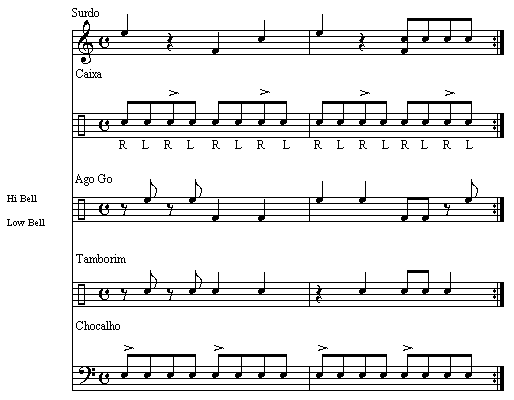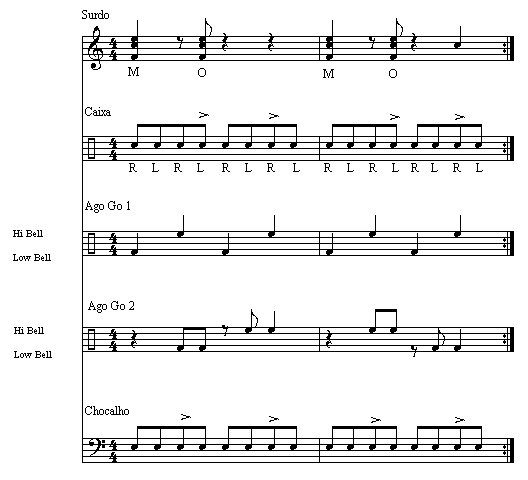
If you would like to start a Samba percussion Group or indeed any kind of Percussion Group and you don't know how to go about it see our Start Up page.
Note: These are very basic and simple patterns for beginners. We recommend you engage an experienced teacher to expand your knowledge. Try the UKSA register for contacts.
Samba Reggae is from the North Eastern Brazilian state of Bahia where there is a concentration of descendants of African slaves. Samba Reggae is a more rolling rhythm with lots of variations and breaks from the Surdos.

Here is an another caixa pattern which could be alternated in sections with the above Samba Regga caixa pattern. You may prefer to use it on it's own in a seperate arrangement as it has a nice swing to it. The accented notes follow the bossa nova clave.

You could have several Repeniques playing the pattern over the Caixas, if you have enough drums. Much Samba Reggae these days, is played with long nylon rods on the Repenique. In the UK these are called whippys and you can purchase them through the UKSA who also hold a register of expert teachers.
In this example M stands for Muffled, O stands for Open

Surdos play a big part in the Baiao rhythm and you can use them to build breaks. You can cut down to just Surdos playing or work in a 'call and answer' section before re-introducing the full rhythm. Call and Answer sections often take the part of short tunes eg. dah deh dum, dah deh dum, dah deh dah deh dah deh dum or anything that sounds tuneful or musical. Naturally, the pattern needs to fit into a logical section of two, four, or eight bars.
Dynamics can be acheived by lowering or raising the volume of the group, instigated by a signal from the mestre, or, by dropping out sections of the band. Maybe dropping down to one section and re-introducing the other sections gradually. A simple dynamic, for example, would involve playing the rhythm and all sections, except the Surdos, dropping out for four bars and then picking the rhythm up after the four bar 'drop out'. It is important that the Surdo section does not drop the tempo when it is left to play on it's own.
Dynamics and breaks can be used together to stunning effect and intelligent use can produce truly great arrangements.
Breaks are signalled by the Mestre who will be carrying an Apito (whistle) around his/her neck. The Apito may be used to signal a break or to play a part in the break. If you are really struggling to bring the band back in after a break, you can even blow one two three four to signal them in, but, you would probably want to replace that with something more musically correct at the earliest opportunity.
If you would like to start a Samba percussion Group or indeed any kind of Percussion Group and you don't know how to go about it see our Start Up page.
Also, take a look at the Drums page on this site. There are some alternative patterns for Caixa or, if you are mixing it up, other patterns you can adapt to Bells, Tamborims or whatever.
I hope that you have found some of this useful. Let me know! Come back soon to check for updates.
E-mail phil@littledrum.co.uk
For music by the author, go to Phil Little Music.
To return to main page click, HOME
All the material on this site is Copyright Phil Little 2000